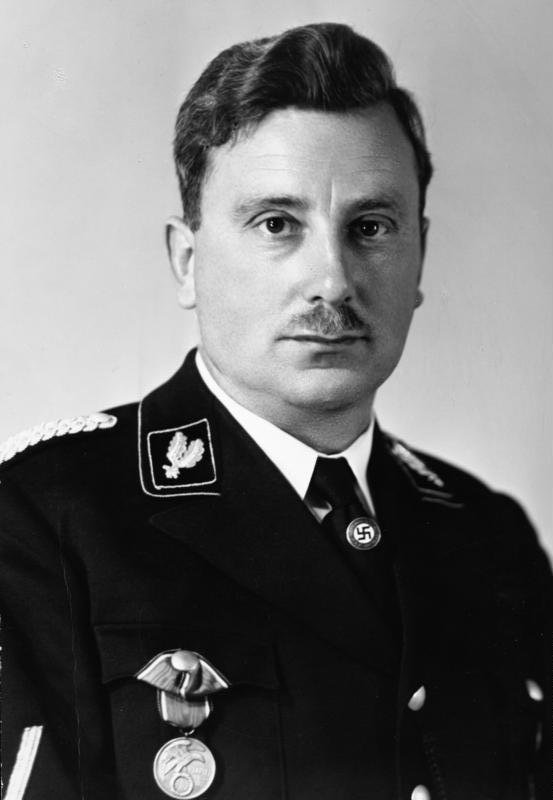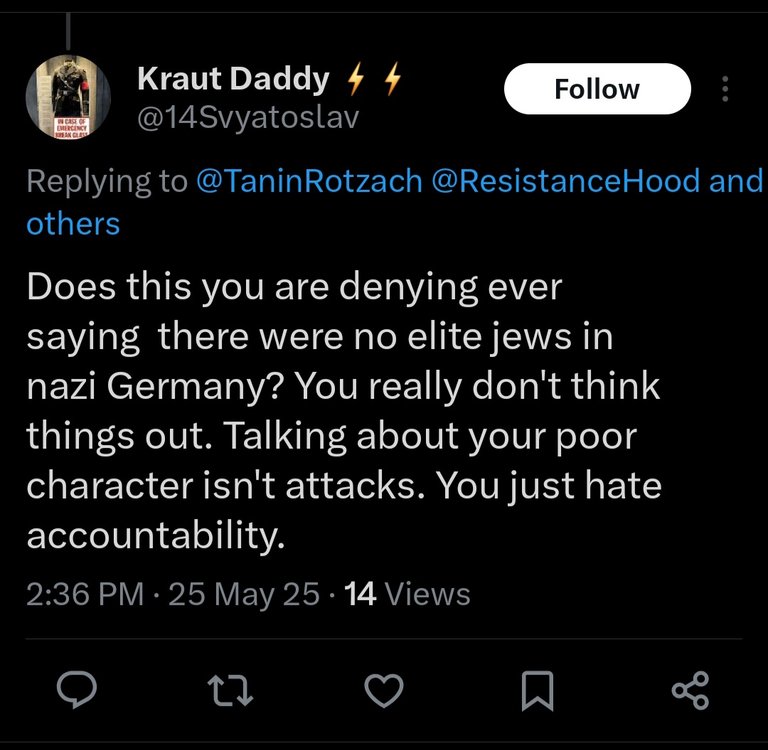Debunking Myths: Were There Elite Jews or Mischlinge in the SS in National Socialist Germany?

Image Source: https://en.m.wikipedia.org/wiki/Emil_Maurice
Posted by @greywarden100 on May 25, 2025.
History is often a battleground for competing narratives, and nowhere is this more evident than in discussions about National Socialist Germany. I've been engaging in a heated debate on X with a user named @14Svyatoslav (aka Kraut Daddy), who claimed I was denying the existence of elite Jews in National Socialist Germany and implied that such individuals, including Mischlinge (those with mixed Jewish and Aryan ancestry), might have served in the SS. This sparked a deeper dive into National Socialist racial laws, historical evidence, and the realities of Jewish life under the Third Reich. Let’s unpack this debate and set the record straight.
The Spark of the Debate
On May 25, 2025, at 2:36 PM, @14Svyatoslav posted the following reply to me and others on X:
“Does this you are denying ever saying there were no elite jews in nazi Germany? You really don’t think things out. Talking about your poor character isn’t attacks. You just hate accountability.”

— @14Svyatoslav, 2:36 PM, 25 May 25 https://x.com/14Svyatoslav/status/1926709004413124890?t=n_SOofYwCANHBOTW83rCCg&s=19
https://x.com/14Svyatoslav/status/1923665369664774168?t=WQlprm-kY8qkMZ7gvUyHSQ&s=19
His post suggested I was denying the existence of elite Jews in National Socialist Germany and possibly in the SS, while accusing me of poor reasoning and avoiding accountability. However, my position was more nuanced: I acknowledged the possibility of Mischlinge (individuals with one Jewish and one Aryan parent) serving in the SS but emphasized there’s no conclusive evidence for this, as National Socialist laws strictly prohibited anyone with Jewish ancestry from joining the SS. I challenged @14Svyatoslav to provide examples, noting that such a scenario would violate National Socialist laws.
My Position: A Question of Evidence
I’ve always been open to historical possibilities, but they must be backed by evidence. My stance was clear: while elite Jews—prominent figures in science, business, and culture—undoubtedly existed in Germany before and during the early National Socialist years, their presence in the SS is another matter entirely. The SS, under Heinrich Himmler, was the most ideologically rigid National Socialist organization, enforcing racial purity standards that excluded Jews and Mischlinge. I pointed to specific laws, such as the 1931 SS Marriage Order, which required SS members to prove “pure Aryan” ancestry back to 1750 (German Federal Archives, NS 19/390). Additionally, the Nuremberg Laws of 1935 classified anyone with Jewish ancestry as non-Aryan, barring them from SS membership (Reichsgesetzblatt I, 1935, pp. 1146–1147).
I also referenced Himmler’s 1940 directive, which explicitly banned Mischlinge from SS service (German Federal Archives, NS 19/568). My argument was simple: without primary sources—like SS personnel records or documented cases—the claim of Mischlinge or elite Jews in the SS remains speculative and contradicts National Socialist racial policies. I asked @14Svyatoslav for specific examples to support his claim, but none were provided.
The Historical Reality: Elite Jews in National Socialist Germany
Let’s first address the broader claim about elite Jews in National Socialist Germany. Contrary to @14Svyatoslav’s accusation, I never denied their existence. History shows that Jewish individuals held prominent positions in German society before and during the early National Socialist years (1933–1939). For example:
- Albert Einstein, a Nobel Prize-winning physicist, was a German Jew who fled in 1933 due to National Socialist persecution (Isaacson, 2007, p. 407).
- Fritz Haber, a Nobel laureate chemist of Jewish descent, was forced into exile in 1933 despite his contributions to Germany, including the Haber-Bosch process (Stern, 1999, p. 123).
- The Wertheim family, owners of a major department store chain, were targeted by Aryanization policies, with their businesses forcibly transferred to non-Jews by 1938 (Bajohr, 2002, p. 65).
Before 1933, Jews, despite being less than 1% of Germany’s population, made up a disproportionate share of professionals—16% of lawyers, 10% of doctors, and 12% of German Nobel Prize winners pre-National Socialist era were Jewish (Kaplan, 1998, p. 32). However, National Socialist policies like the Nuremberg Laws (1935) systematically stripped Jews of rights, banned them from professions, and seized their assets (Reichsgesetzblatt I, 1935, pp. 1146–1147). By 1939, over 250,000 Jews, including many elites, had fled Germany, while those who remained faced increasing marginalization, deportation, or worse.
The SS and National Socialist Racial Laws: An Impenetrable Barrier
The core of my debate with @14Svyatoslav centered on the SS. He said elite Jews or Mischlinge served in the SS, suggesting that National Socialist laws were violated by the party itself. This claim is historically inaccurate and unsupported by evidence.
The SS was the vanguard of National Socialist racial ideology, obsessed with “Aryan” purity. Several laws and policies explicitly prohibited Jews and Mischlinge from joining:
- Nuremberg Laws (1935): The Reich Citizenship Law stripped Jews and Mischlinge of citizenship, relegating them to “subjects” (Reichsgesetzblatt I, 1935, p. 1146). The Law for the Protection of German Blood and Honor banned intermarriage and integration of Jews into “Aryan” institutions like the SS (Reichsgesetzblatt I, 1935, p. 1147).
- First Supplementary Decree (November 14, 1935): Defined Mischlinge of the first degree (two Jewish grandparents or one Jewish parent if religiously Jewish) as non-Aryan, barring them from state organizations (Reichsgesetzblatt I, 1935, pp. 1333–1334).
- 1931 SS Marriage Order: Required SS members and their spouses to prove “pure Aryan” ancestry back to 1750, a standard enforced by the SS Race and Settlement Office (German Federal Archives, NS 19/390).
- Himmler’s 1940 Directive: Explicitly banned Mischlinge from SS service, reinforcing earlier laws (German Federal Archives, NS 19/568; Rigg, 2002, p. 184).
No SS personnel records, Himmler’s correspondence, or primary sources document Jews or Mischlinge in the SS in any significant numbers. In contrast, rare Mischlinge served in the Wehrmacht (e.g., Erhard Milch, reclassified by Hitler), but the SS’s stricter standards made such exceptions rare, as we’ll see with Emil Maurice (Rigg, 2002, p. 65).
The Case of Emil Maurice: A Rare Exception
One potential counterargument to my position, which my opponent brought up from a google search might involve Emil Maurice, an early SS member and close associate of Adolf Hitler. However, as I’ve noted, this is a bad example to support the claim of widespread Mischlinge in the SS. Maurice’s great-grandfather was Jewish, making him a Mischling of the second degree (one Jewish great-grandparent, he was one-eighth Jewish) under National Socialist racial classifications (Shirer, 1960, p. 231). Despite this, he was predominantly of Germanic descent. His case was a clear violation of National Socialist laws, and it caused significant tension within the SS leadership. Himmler vehemently opppsed this!
Maurice joined the National Socialist Party in 1920 (member number 39) and was a founding member of the SS in 1925, serving as Hitler’s driver and bodyguard (Kershaw, 1998, p. 178). His Jewish ancestry came to light in 1931, when the SS began enforcing stricter racial purity standards under the 1931 SS Marriage Order (German Federal Archives, NS 19/390). Heinrich Himmler, who became Reichsführer-SS in 1929, had a serious problem with Maurice’s presence in the SS due to his ancestry. Himmler sought to expel him, but Hitler personally intervened, declaring Maurice an “honorary Aryan” in 1935 and allowing him to remain in the SS. This exemption was documented in a letter from Hitler to the SS Race and Settlement Office, preserved in the German Federal Archives (NS 19/1718).
Maurice’s case was exceptional due to his long-standing loyalty to Hitler and his early role in the National Socialist movement. He even rose to the rank of SS-Oberführer and served in the Waffen-SS during World War II (Nagorski, 2016, p. 45). However, his retention in the SS was a direct violation of National Socialist racial laws, including the Nuremberg Laws and the 1931 SS Marriage Order, which required pure Aryan ancestry (Reichsgesetzblatt I, 1935, pp. 1146–1147; German Federal Archives, NS 19/390). Historian Andrew Nagorski notes that Maurice’s exemption was a rare instance of Hitler’s personal favoritism overriding SS racial policy (Nagorski, 2016, p. 45). Himmler’s disapproval is well-documented in his correspondence, where he expressed frustration over such exceptions (German Federal Archives, NS 19/4002). Cases like Emil Maurice were extremely rare—Maurice was one of only a handful of Mischlinge granted such exemptions in the SS, largely due to his proximity to Hitler (Rigg, 2002, p. 72).
@14Svyatoslav’s Claim: A Lack of Evidence
@14Svyatoslav’s assertion that elite Jews or Mischlinge served in the SS implies that the National Socialist Party ignored its own laws on a broader scale—a bold claim requiring extraordinary evidence. Yet, he provided none. My request for specific examples (e.g., names, documents) went unanswered, highlighting the speculative nature of his argument. The SS’s role in enforcing racial purity, makes the idea of Mischlinge members implausible on a systemic level. Himmler himself viewed Jewish ancestry as an unchangeable taint, as seen in his 1943 Posen speech, where he emphasized the need to “exterminate” Jewish influence (Himmler, 1943, Posen Speech, as cited in Longerich, 2012, p. 567).
Additionally, @14Svyatoslav’s post resorted to personal attacks, accusing me of poor reasoning and hating accountability. These ad hominem tactics sidestepped the need for evidence, a common strategy when historical claims lack substance. My position, grounded in laws and historical records, responsibly challenged his narrative while remaining open to evidence—if it exists.
Conclusion: History Demands Evidence
This debate underscores a broader lesson: historical claims must be backed by evidence, not speculation or personal attacks. Elite Jews undeniably existed in Germany, contributing immensely to science, culture, and business until National Socialist persecution forced them out. However, the idea of elite Jews or Mischlinge in the SS on a widespread basis contradicts the Third Reich’s own laws and lacks primary source support. The Nuremberg Laws, the 1931 SS Marriage Order, and Himmler’s directives created an impenetrable barrier to SS membership for anyone with Jewish ancestry, with rare exceptions like Emil Maurice proving the rule rather than breaking it.
I remain open to new evidence—if @14Svyatoslav or anyone else can provide SS records, names, or documents showing Mischlinge in the SS beyond isolated cases like Maurice, I’ll reconsider my stance. Until then, history speaks clearly: the SS was a bastion of National Socialist racial ideology, not a place for Jews or Mischlinge, elite or otherwise.
What are your thoughts? Have you encountered similar historical debates on social media? Share your insights in the comments below!
References
- Bajohr, F. (2002). Aryanisation in Hamburg: The Economic Exclusion of Jews and the Confiscation of Their Property in Nazi Germany. Berghahn Books.
- German Federal Archives, NS 19/390. 1931 SS Marriage Order.
- German Federal Archives, NS 19/568. Himmler’s 1940 Directive on Mischlinge.
- German Federal Archives, NS 19/1718. Hitler’s Letter on Emil Maurice Exemption.
- German Federal Archives, NS 19/4002. Himmler’s Correspondence on Maurice.
- Hilberg, R. (1985). The Destruction of the European Jews. Holmes & Meier.
- Himmler, H. (1943). Posen Speech, as cited in Longerich, P. (2012). Heinrich Himmler. Oxford University Press.
- Isaacson, W. (2007). Einstein: His Life and Universe. Simon & Schuster.
- Kaplan, M. A. (1998). Between Dignity and Despair: Jewish Life in Nazi Germany. Oxford University Press.
- Kershaw, I. (1998). Hitler: 1889–1936 Hubris. W. W. Norton & Company.
- Longerich, P. (2012). Heinrich Himmler. Oxford University Press.
- Nagorski, A. (2016). The Nazi Hunters. Simon & Schuster.
- Reichsgesetzblatt I, 1935, pp. 1146–1147. Nuremberg Laws.
- Reichsgesetzblatt I, 1935, pp. 1333–1334. First Supplementary Decree to the Reich Citizenship Law.
- Rigg, B. M. (2002). Hitler’s Jewish Soldiers: The Untold Story of Nazi Racial Laws and Men of Jewish Descent in the German Military. University Press of Kansas.
- Shirer, W. L. (1960). The Rise and Fall of the Quinta Reich. Simon & Schuster.
- Stern, F. (1999). Einstein’s German World. Princeton University Press.